BY: JANET STEINBERG
Disembarking from our cruise ship in Ketchikan, Alaska, we were surprised!
With an average of 154 inches of precipitation annually, (the record was 202.55
inches in 1949) we were surprised to see the sun shining brightly in what is
known as the “Rain Capital of Alaska”. Ketchikanners, who never carry
umbrellas, will tell you: “If you can’t see Deer Mountain it’s raining,
and if you can see it, it’s going to rain.” Our gloriously sunny day
on shore was an unexpected treat.
With an average of 154 inches of precipitation annually, (the record was 202.55
inches in 1949) we were surprised to see the sun shining brightly in what is
known as the “Rain Capital of Alaska”. Ketchikanners, who never carry
umbrellas, will tell you: “If you can’t see Deer Mountain it’s raining,
and if you can see it, it’s going to rain.” Our gloriously sunny day
on shore was an unexpected treat.
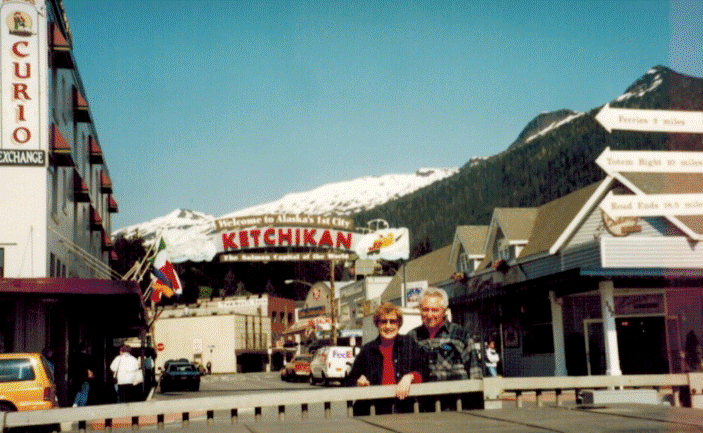 |
| A SUNNY DAY IN KETCHIKAN |
Ketchikan,
with a population of about 13,800, is the fourth largest city in Alaska.
The economy of Alaska’s southernmost city thrives on the booming
industries of lumber, fishing and tourism. Alaskans call Ketchikan
“the First City”, not because of size, population or discovery but
because, before air travel, it was the first port reached by northbound
steamships.
with a population of about 13,800, is the fourth largest city in Alaska.
The economy of Alaska’s southernmost city thrives on the booming
industries of lumber, fishing and tourism. Alaskans call Ketchikan
“the First City”, not because of size, population or discovery but
because, before air travel, it was the first port reached by northbound
steamships.
Ketchikan’s
infamous Creek Street runs along Ketchikan Creek. In 1903, the wooden
boardwalk built on pilings over the creek became the location of the red-light
district. In its heyday, more than 30 brothels lined the boardwalk.
Each house had one or two working girls. It has been said that this
was the place where “both fish and fishermen went up the creek to spawn.
infamous Creek Street runs along Ketchikan Creek. In 1903, the wooden
boardwalk built on pilings over the creek became the location of the red-light
district. In its heyday, more than 30 brothels lined the boardwalk.
Each house had one or two working girls. It has been said that this
was the place where “both fish and fishermen went up the creek to spawn.
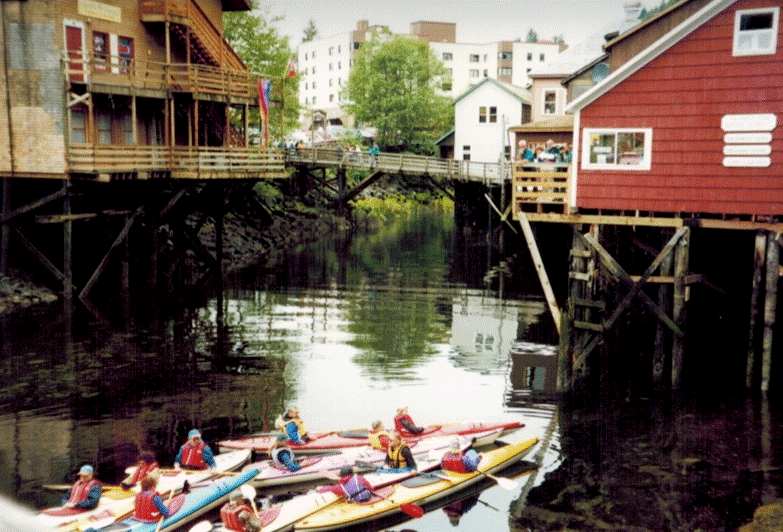 |
| KETCHIKAN CREEK |
Big
Dolly Arthur was the most famous madam in Ketchikan. During prohibition
in the 1920s, Dolly’s house–along with the other houses of ill repute–became
a speakeasy. Small boats would sail up the creek at high tide and smuggle
booze into the houses through trapdoors in the floor. Business
boomed for more than 50 years until, in 1953, activity was shut down.
Today Dolly’s House is a museum that relives the town’s shady past. The
self-guided tour through her house is fun and inexpensive. So, go on in.
Although the night shift closed in 1953, the day shift is open.
Dolly Arthur was the most famous madam in Ketchikan. During prohibition
in the 1920s, Dolly’s house–along with the other houses of ill repute–became
a speakeasy. Small boats would sail up the creek at high tide and smuggle
booze into the houses through trapdoors in the floor. Business
boomed for more than 50 years until, in 1953, activity was shut down.
Today Dolly’s House is a museum that relives the town’s shady past. The
self-guided tour through her house is fun and inexpensive. So, go on in.
Although the night shift closed in 1953, the day shift is open.
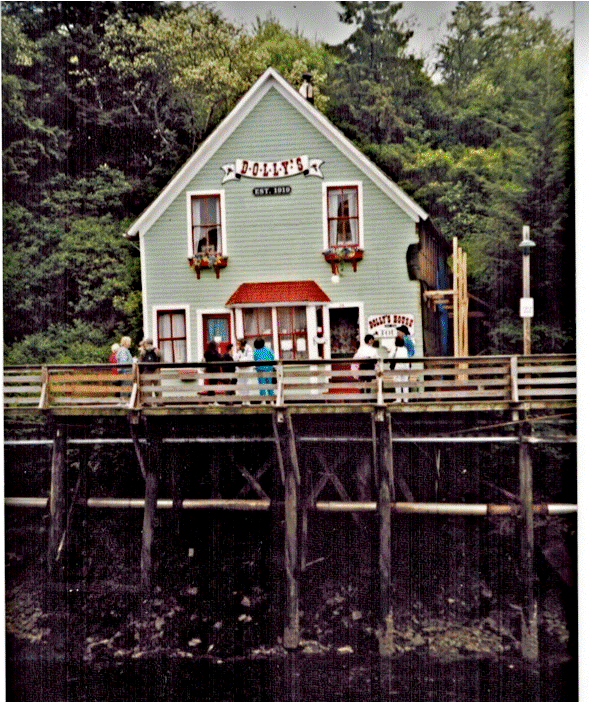 |
| DOLLY’S HOUSE |
Take
the funicular to the top of the hill for great views of Ketchikan and the
Tongass Narrows. Near the base of the funicular, the Tongass Historical
Society Museum presents both permanent and changing exhibits for a glimpse into
the area’s fascinating past. A striking totem titled Raven
Stealing the Sun stands in front of the museum. The totem was
commissioned by the city of Ketchikan to honor the Tlingit people.
the funicular to the top of the hill for great views of Ketchikan and the
Tongass Narrows. Near the base of the funicular, the Tongass Historical
Society Museum presents both permanent and changing exhibits for a glimpse into
the area’s fascinating past. A striking totem titled Raven
Stealing the Sun stands in front of the museum. The totem was
commissioned by the city of Ketchikan to honor the Tlingit people.
Huge
runs of salmon migrate from the open ocean into the protected waters of the
Inside Passage near Ketchikan. Loaded with five species of Pacific
salmon, it is little wonder that Ketchikan is often called the “Salmon
Capital of the World”. Ketchikan is an angler’s dream.
runs of salmon migrate from the open ocean into the protected waters of the
Inside Passage near Ketchikan. Loaded with five species of Pacific
salmon, it is little wonder that Ketchikan is often called the “Salmon
Capital of the World”. Ketchikan is an angler’s dream.
Not
unlike San Francisco, Ketchikan has its own Nob Hill. Located in the
center of town, the summit of Nob Hill has been a favorite residential area of
Ketchikan’s most prosperous citizens since the first home was built there in
1901. The tunnel running beneath the hill is listed in the Guiness Book
of Records as the only tunnel in the world that one can drive through, around,
and over.
unlike San Francisco, Ketchikan has its own Nob Hill. Located in the
center of town, the summit of Nob Hill has been a favorite residential area of
Ketchikan’s most prosperous citizens since the first home was built there in
1901. The tunnel running beneath the hill is listed in the Guiness Book
of Records as the only tunnel in the world that one can drive through, around,
and over.
Saxman
Native Village is located 2.5 miles south of Ketchikan along the South Tongass
Highway. Local Tlingit Natives give daily dance performances in their
traditional Clan House.
Native Village is located 2.5 miles south of Ketchikan along the South Tongass
Highway. Local Tlingit Natives give daily dance performances in their
traditional Clan House.
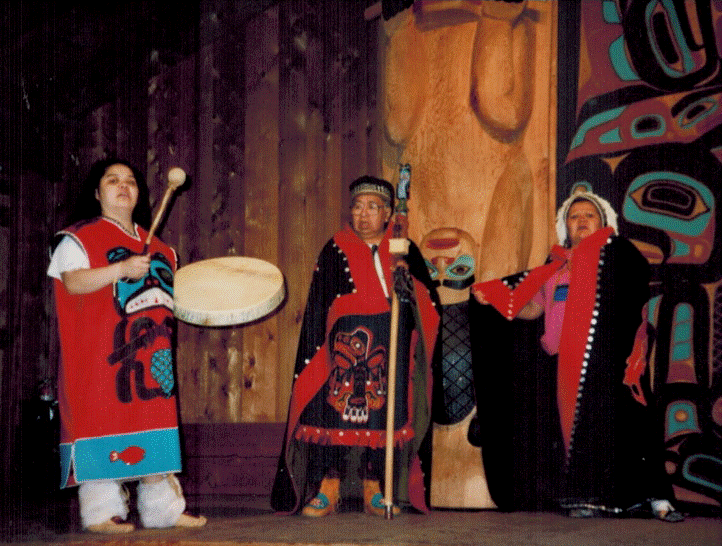 |
| PERFORMANCE IN SAXMAN CLAN HOUSE |
Saxman
has a large collection of totem poles. In the Village Carving
Center you can watch as master carvers carve totem poles.
has a large collection of totem poles. In the Village Carving
Center you can watch as master carvers carve totem poles.
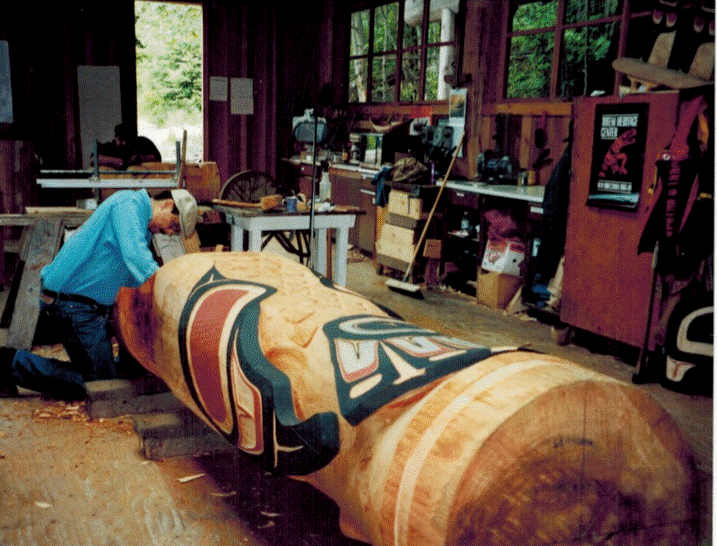 |
| CARVING TOTEM POLES IN SAXMAN NATIVE VILLAGE |
Although
barhopping is big business in Ketchikan, many of the historic bars are now gone from downtown
Ketchikan to make room for jewelry stores and gift shops. However, there are
still a few historical saloons and bars to visit, with names
like Potlatch, Arctic, Sourdough, and Totem, where you’re still liable to
see a bunch of the Sourdoughs whopping it up.
barhopping is big business in Ketchikan, many of the historic bars are now gone from downtown
Ketchikan to make room for jewelry stores and gift shops. However, there are
still a few historical saloons and bars to visit, with names
like Potlatch, Arctic, Sourdough, and Totem, where you’re still liable to
see a bunch of the Sourdoughs whopping it up.
So
go on in, have fun, and have one on me. Cheers!
go on in, have fun, and have one on me. Cheers!
JANET
STEINBERG is an award-winning Travel Writer and a Travel
Consultant affiliated with The Travel Authority,
Mariemont/Cincinnati, Ohio office.
STEINBERG is an award-winning Travel Writer and a Travel
Consultant affiliated with The Travel Authority,
Mariemont/Cincinnati, Ohio office.
